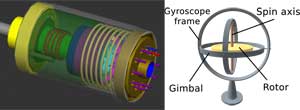Difference Between Gyroscope and Accelerometer
 Gyroscope vs Accelerometer
Gyroscope vs Accelerometer
The difference between gyroscope and accelerometer is that the former can sense rotation, the latter cannot. A 3 axis accelerometer has the ability to gauge the orientation of a stationary platform relative to the earth’s surface. If the platform happens to be in free fall, the acceleration will be shown to be zero. If it is only accelerating in a particular direction the acceleration will be indistinguishable from the acceleration being provided by the earth’s gravitational pull. So an accelerometer alone cannot be used to have an aircraft maintain a particular orientation.
A gyroscope on the other hand has the capability of measuring the rate of rotation around a particular axis. For instance if a gyroscope is used to gauge the rate of rotation around the roll axis of an aircraft, it will come up with a non zero roll value, so long as the aircraft continues to roll, but shows zero if the roll stops.
Another way of identifying the difference between a gyroscope and an accelerometer is by understanding that a gyroscope helps measure or maintains orientation, using the principles of angular momentum, whereas an accelerometer measures vibration. Another difference pertains to the fact that a gyroscope gives an indication of the angular rate, whereas an accelerometer measures linear acceleration.
The 2 axis accelerometer gives you the direction of gravity on your balancing instrument. Typically a gyroscope is used to measure angular position premised on the principle of rigidity of space of the gyroscope. A gyroscope has many practical applications. It can be used for navigation, on Unmanned Aerial Vehicles, and radio controlled helicopters. An accelerometer on the other hand sees extensive application. It is used in engineering, machinery monitoring, building and structural monitoring, medicine, navigation, transport and consumer electronics.
The use of accelerometers in consumer electronics is a relatively new phenomenon. These are used is smart phones and devices such as play station. They are also incorporated in new generation laptops and notebooks.
We can see that both gyroscope and accelerometer have their individual characteristics and functions. Either of these can be critically important when appropriately used.
Summary:
1. Accelerometermeasures linear motion and gravity.
2. Accelerometer detects and measures electrical current that derives from muscular action.
3. The magnitude of the signal in the case of accelerometer is biased by gravity. This is not the case with gyroscope.
4. Information pertains to bandwidth and frequency available to the extent of zero frequency in the case of gyroscope. That may not be the case with an accelerometer.
5. A onetime integration is sufficient to achieve angular displacement in the case of gyroscope, whereas a difficult two time integration is required in the case of accelerometer.
6. There is high signal to noise ratio in the case of gyroscope, while in accelerators, there is mostly a low signal to noise ratio.
- Difference Between Schizophrenia and Psychosis - March 7, 2024
- Difference Between African and Asian Elephants - March 7, 2024
- Difference Between Sunscreen and Sunblock - February 15, 2024

what is the difference in power consumption between a similar sized gyro and accelerometer?
What is the typical size of a gyroscope for monitoring purpose? Usually we use 3D accelerometers (X-Y-Z) with two angular rate sensors. Just curious how practical a gyroscope would be. Thanks.
How can Gyroscope “measures linear motion” ?
that was a typo. the summary should say that accelerometer measures linear acceleration.
It is wrong. We can calculate rotational angles with accelerometer also. But we use gyrometer reading along with accelerometer only to provide more precision.
3 axis accelerometer can use as gyroscope????